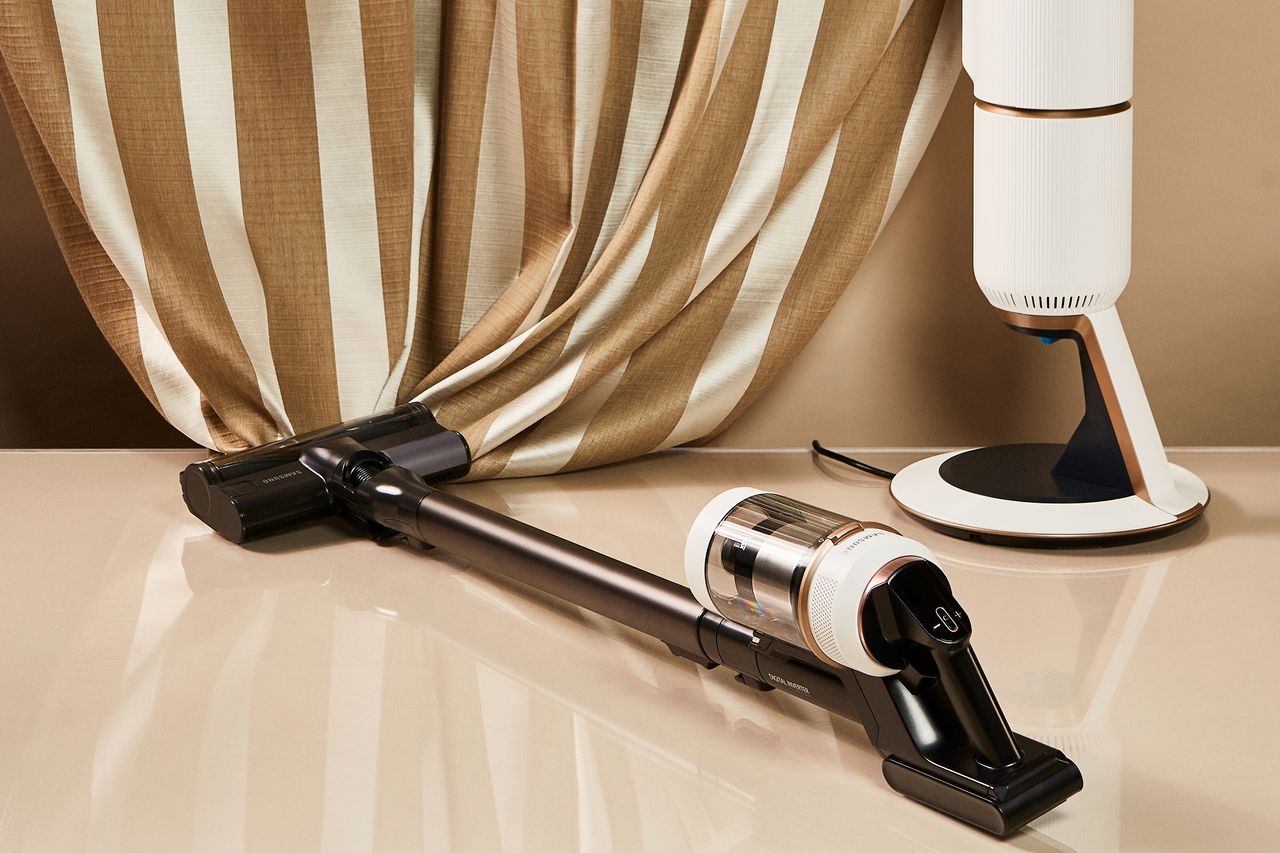3 Reasons You Should Buy a Stick Vacuum—And 3 Reasons They Suck
Convenient, compact and light, cordless vacuums from companies like Dyson and Samsung have become covetable status symbols for some. But they come with some negatives, too.
JILL KOCH, 39, bought her first cordless vacuum because it was pink. “I didn’t look at the brand, I didn’t look at the price. I saw the colour and was like, ‘I have to have it,’” said the Cincinnati-based home organisation and cleaning blogger. Koch, who owns almost a dozen vacuums, says her newest cordless stick, the Shark Wandvac, gets the most use. She finds its motor powerful enough to handle most tasks. But more important, because of its sleek look, “it’s not even weird to store it in plain sight,” she said. Whenever she sees something that needs cleaning, that vacuum is within reach. She can clear the mess, dump out its dustbin into a trash can, and re-dock the vacuum in a minute or two.
Cordless stick vacuums aren’t new—British manufacturer Dyson released its first cordless stick vacuum in 2010—but the battery-powered, bagless models have become more popular, largely due to their convenience. In 2018, a year after telling Bloomberg that cordless vacuums were driving his namesake company’s growth, James Dyson announced it would no longer bother developing corded models. Convenience, however, isn’t cheap. While you can find excellent corded upright vacuums for under $200, the latest cordless option from Dyson, its Gen 5 Outsize, costs $1,050.
Some experts say ditching your corded model is unwise. Cordless vacuums have a place in your cleaning arsenal, but they aren’t a replacement for a more powerful machine like an upright model with a bag, said Ken Bank, a third-generation vacuum expert and president of Livonia, Mich.-based Bank’s Vacuum Superstores. “The technology has improved a lot,” he said, “but [stick vacuums] aren’t anywhere near as powerful as a vacuum cleaner with a cord and a real motor in it.”
Here’s what to consider before going cordless.
The Pros
Cordless vacuums are light and maneuverable
They are a great choice for folks with strength or mobility issues, or those who just don’t want to push around a heavy vacuum.
Cordless vacuums are supremely versatile
Most vacuums come with multiple heads and attachments, but cordless vacuums make them easier to use. Once you’ve swapped out the long wand for a dust brush, crevice tool or upholstery cleaner, your vacuum easily fits in hand. It’s ideal for cleaning the inside of a car or drawers.
Cordless vacuums let you clean more spontaneously
Since they can be stored on docks or stands, a cordless vacuum is always within reach. If you see a mess, you can have cleaned it before someone with a corded vacuum might have time to locate a plug.
The Cons
Cordless vacuums don’t contain dirt that well
When it comes to filtration and dust containment, nothing beats a classic vacuum with a bag, says Bank, “The cordless ones [are] not sealed up tight,” Bank said. Each time you open your vacuum’s dustbin to dump it out in the trash, he says, you release dust.
Cordless vacuums require you to clean within a time limit
Stick vacuums are battery powered. Batteries die. That means an all-day deep clean might require multiple charging stops. While some cordless vacs can run for up to an hour at a time, estimates shorten when you’re using stronger suction settings.
Cordless vacuums can be tough to fix
Bank doesn’t just sell vacuums; he repairs them, too. He says most stick vacuums are a service nightmare. “They’re hard to maintain, you can’t really take them apart to clean them, and if they break, most companies don’t make parts for them,” he said.
Don’t Get Left In the Dust
For spills, quick pick-ups, and in-between the deep cleans, it’s tough to beat a stick. Two to consider:
A sweeper with storage
Samsung’s Bespoke Jet AI Cordless is not designed to be hidden away in a closet. Its sleek, free-standing docking station doubles as a charger and a canister that auto-empties the vacuum with enough capacity for a few days’ worth of dirt. The company says a battery charge can last for 100 minutes, though that might vary as the vacuum’s software adjusts the suction level based on the floor surface it detects underneath. $US999, Samsung.com
Dust disrupter
Designed by two former Dyson R&D experts, the Pure Cordless by Lupe (pronounced “loop”) has a beefy, 9-cell battery and a 1-litre dust bin. Though one charge lasts around an hour when the vacuum is set on low suction, and just 15 minutes on max, you can buy a second battery ($149) and keep it charged for longer cleaning sessions. Unlike many other models, the Lupe is easily serviceable: You can buy an affordable replacement for basically every component. It also comes with an industry-leading five-year warranty. $US699, LupeTechnology.com
The Wall Street Journal is not compensated by retailers listed in its articles as outlets for products. Listed retailers frequently are not the sole retail outlets.
 Copyright 2020, Dow Jones & Company, Inc. All Rights Reserved Worldwide. LEARN MORE
Copyright 2020, Dow Jones & Company, Inc. All Rights Reserved Worldwide. LEARN MORE
This stylish family home combines a classic palette and finishes with a flexible floorplan
Just 55 minutes from Sydney, make this your creative getaway located in the majestic Hawkesbury region.
The remote northern island wants more visitors: ‘It’s the rumbling before the herd is coming,’ one hotel manager says
As European hot spots become overcrowded , travellers are digging deeper to find those less-populated but still brag-worthy locations. Greenland, moving up the list, is bracing for its new popularity.
Aria Varasteh has been to 69 countries, including almost all of Europe. He now wants to visit more remote places and avoid spots swarmed by tourists—starting with Greenland.
“I want a taste of something different,” said the 34-year-old founder of a consulting firm serving clients in the Washington, D.C., area.
He originally planned to go to Nuuk, the island’s capital, this fall via out-of-the-way connections, given there wasn’t a nonstop flight from the U.S. But this month United Airlines announced a nonstop, four-hour flight from Newark Liberty International Airport in New Jersey to Nuuk. The route, beginning next summer, is a first for a U.S. airline, according to Greenland tourism officials.
It marks a significant milestone in the territory’s push for more international visitors. Airlines ran flights with a combined 55,000 seats to Greenland from April to August of this year, says Jens Lauridsen, chief executive officer of Greenland Airports. That figure will nearly double next year in the same period, he says, to about 105,000 seats.
The possible coming surge of travellers also presents a challenge for a vast island of 56,000 people as nearby destinations from Iceland to Spain grapple with the consequences of over tourism.
Greenlandic officials say they have watched closely and made deliberate efforts to slowly scale up their plans for visitors. An investment north of $700 million will yield three new airports, the first of which will open next month in Nuuk.
“It’s the rumbling before the herd is coming,” says Mads Mitchell, general manager of Hotel Nordbo, a 67-room property in Nuuk. The owner of his property is considering adding 50 more rooms to meet demand in the coming years.
Mitchell has recently met with travel agents from Brooklyn, N.Y., South Korea and China. He says he welcomes new tourists, but fears tourism will grow too quickly.
“Like in Barcelona, you get tired of tourists, because it’s too much and it pushes out the locals, that is my concern,” he says. “So it’s finding this balance of like showing the love for Greenland and showing the amazing possibilities, but not getting too much too fast.”
Greenland’s buildup
Greenland is an autonomous territory of Denmark more than three times the size of Texas. Tourists travel by boat or small aircraft when venturing to different regions—virtually no roads connect towns or settlements.
Greenland decided to invest in airport infrastructure in 2018 as part of an effort to expand tourism and its role in the economy, which is largely dependent on fishing and subsidies from Denmark. In the coming years, airports in Ilulissat and Qaqortoq, areas known for their scenic fjords, will open.
One narrow-body flight, like what United plans, will generate $200,000 in spending, including hotels, tours and other purchases, Lauridsen says. He calls it a “very significant economic impact.”
In 2023, foreign tourism brought a total of over $270 million to Greenland’s economy, according to Visit Greenland, the tourism and marketing arm owned by the government. Expedition cruises visit the territory, as well as adventure tours.
United will fly twice weekly to Nuuk on its 737 MAX 8, which will seat 166 passengers, starting in June .
“We look for new destinations, we look for hot destinations and destinations, most importantly, we can make money in,” Andrew Nocella , United’s chief commercial officer, said in the company’s earnings call earlier in October.
On the runway
Greenland has looked to nearby Iceland to learn from its experiences with tourism, says Air Greenland Group CEO Jacob Nitter Sørensen. Tiny Iceland still has about seven times the population of its western neighbour.
Nuuk’s new airport will become the new trans-Atlantic hub for Air Greenland, the national carrier. It flies to 14 airports and 46 heliports across the territory.
“Of course, there are discussions about avoiding mass tourism. But right now, I think there is a natural limit in terms of the receiving capacity,” Nitter says.
Air Greenland doesn’t fly nonstop from the U.S. because there isn’t currently enough space to accommodate all travellers in hotels, Nitter says. Air Greenland is building a new hotel in Ilulissat to increase capacity when the airport opens.
Nuuk has just over 550 hotel rooms, according to government documents. A tourism analysis published by Visit Greenland predicts there could be a shortage in rooms beginning in 2027. Most U.S. visitors will stay four to 10 nights, according to traveler sentiment data from Visit Greenland.
As travel picks up, visitors should expect more changes. Officials expect to pass new legislation that would further regulate tourism in time for the 2025 season. Rules on zoning would give local communities the power to limit tourism when needed, says Naaja H. Nathanielsen, minister for business, trade, raw materials, justice and gender equality.
Areas in a so-called red zone would ban tour operators. In northern Greenland, traditional hunting takes place at certain times of year and requires silence, which doesn’t work with cruise ships coming in, Nathanielsen says.
Part of the proposal would require tour operators to be locally based to ensure they pay taxes in Greenland and so that tourists receive local knowledge of the culture. Nathanielsen also plans to introduce a proposal to govern cruise tourism to ensure more travelers stay and eat locally, rather than just walk around for a few hours and grab a cup of coffee, she says.
Public sentiment has remained in favour of tourism as visitor arrivals have increased, Nathanielsen says.
—Roshan Fernandez contributed to this article.
This stylish family home combines a classic palette and finishes with a flexible floorplan
Just 55 minutes from Sydney, make this your creative getaway located in the majestic Hawkesbury region.






















